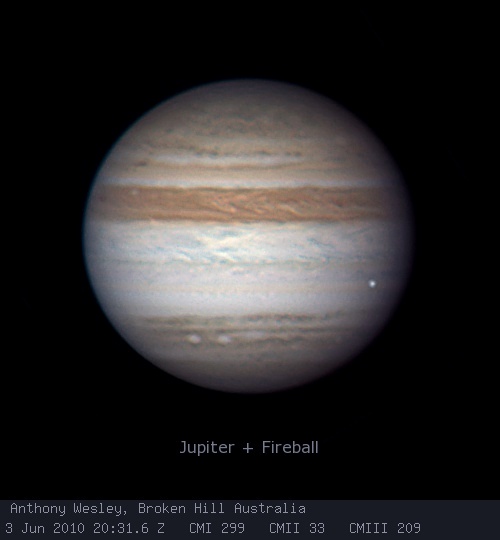Other services: Planetmap | Junocam | Jovian impacts | Venus BepiColombo Flyby

Background: The Giant planet Jupiter has been hit by small objects (5-20 m in size) several times in the last decades. Objects of this size are too small to leave any observable feature in the atmosphere but when they collide with the planet they produce short flashes of light of 1-2 seconds that can be seen using small telescopes and recorded in video observations of the planet. Studying these object we hope to learn about the potential of Jupiter in protecting the Earth from impacts with small asteroids and comets and also about the population of small objects in the outer solar system. You can learn about this impacts by reading one of the many articles freely available in the internet. Here are a few links.
IMPORTANT NOTE: We strongly advise to observers wishing to collaborate in the detection of impacts in Jupiter to use the latest version of the DeTeCt software maintained by Marc Delcroix at http://www.astrosurf.com/planetessaf/doc/project_detect.php. The pages here in PVOL here outdated and are kept only to document past versions of the software and past advances in the area.
Aim of this page: Our goal is to increase the effectivity whith which impacts are found in Jupiter. Impact flashes are so short than in many cases they can be skipped by image processing software or a casual visualization of a long video observation. In order to maximize the capacity to find impacts a software tool able to detect faint impacts may improve the detectability of these events. This page features software tools (JID and DeTeCt2.0 and DeTeCt3.1) for inspection of video observations of Jupiter with the aim of recovering impacts of small objects producing bright and short fireballs in the atmosphere of Jupiter. In particular DeTeCt3.1 has been built as part of the Detection activities of the Planetary and Space Weather Services of the Europlanet-2020 research infrastructure with funds from the European Comission.
Status of impacts in Jupiter: Five bolides have been identified on video observations of Jupiter obtained by amateur astronomers in June and August 2010, in September 2012, in March 2016 and in May 2017. Here you can find open source software programs released to the large community of amateur astronomers who obtain video observations of Jupiter. You will also find information about the impacts observed, the original observations of these impacts and statistics of the search of impacts from analysis of several thousands of video files (statistical analysis courtesy of Marc Delcroix).
Acknowledgement: This project is part of the PSWS (Planetary Space Weather Services), which is part of Europlanet 2020 RI. Europlanet 2020 RI has received funding from the European Union's Horizon 2020 research and innovation programme under grant agreement No 654208. We sincerely acknowledge help from Marc Delcroix and many other relevant members of the community of amateur astronomers.
Software Developers: Luis Calderon and Ricardo Hueso (first basic algorithms), Juan Carlos Moreno (JID), Marc Delcroix (DeTeCt, all versions) and Jon Juaristi (DeTeCt3.0).
Scientific Coordination: Ricardo Hueso, Agustin Sanchez-Lavega and Josep Maria-Gomez (Grupo de Ciencias Planetarias, UPV-EHU, Spain)
Acknowledgements: Emil Kraaikamp, John H. Rogers. We are also very gratefull to all the observers
who identified and shared their observations of impacts in Jupiter. The following is a list of all observers with a successfull detection:
Write your comments / suggestion to: Ricardo Hueso  .
.